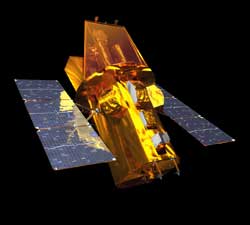The Neil Gehrels Swift Observatory
 Gamma-ray bursts (GRBs) are the most powerful explosions the Universe has seen since the Big Bang. They occur approximately once per day and are brief, but intense, flashes of gamma radiation. They come from all different directions of the sky and last from a few milliseconds to a few hundred seconds. So far scientists do not know what causes them. Do they signal the birth of a black hole in a massive stellar explosion? Are they the product of the collision of two neutron stars? Or is it some other exotic phenomenon that causes these bursts?
Gamma-ray bursts (GRBs) are the most powerful explosions the Universe has seen since the Big Bang. They occur approximately once per day and are brief, but intense, flashes of gamma radiation. They come from all different directions of the sky and last from a few milliseconds to a few hundred seconds. So far scientists do not know what causes them. Do they signal the birth of a black hole in a massive stellar explosion? Are they the product of the collision of two neutron stars? Or is it some other exotic phenomenon that causes these bursts?
With Swift, a NASA mission with international participation, scientists have a tool dedicated to answering these questions and solving the gamma-ray burst mystery. Its three instruments give scientists the ability to scrutinize gamma-ray bursts like never before. Within seconds of detecting a burst, Swift relays its location to ground stations, allowing both ground-based and space-based telescopes around the world the opportunity to observe the burst's afterglow. Swift is part of NASA's medium explorer (MIDEX) program and was launched into a low-Earth orbit on a Delta 7320 rocket on November 20, 2004. The Principal Investigator is Dr. Brad Cenko (NASA-GSFC).
» NASA Release
» Multimedia
» Nature Paper
Swift Operations Status
Operations are nominal.
Swift Resources
» GRB, BA, & TOO Contact Information» BAT Transient Lightcurves
» Swift Supernovae
» Observing Schedule
» Journal Papers Related to Swift
» Swift Press Release Image Archive
» Swift User's Group (SUG)
» Swift Mission Participants
Latest Swift GRBs
Latest Swift News
Feb 6, 2024
Swift Cycle 20 Results
Swift Cycle 20 Recommended Targets and Proposals have been posted.
Sep 7, 2023
NASA's Swift Learns a New Trick, Spots a Snacking Black Hole
Using NASA's Neil Gehrels Swift Observatory, which launched in 2004, scientists have discovered a black hole in a distant galaxy repeatedly nibbling on a Sun-like star. The object heralds a new era of Swift science made possible by a novel method for analyzing data from the satellite's X-ray Telescope (XRT).
+ Read More
Mar 28, 2023
NASA Missions Study What May Be a 1-In-10,000-Year Gamma-ray Burst
On Sunday, Oct. 9, 2022, a pulse of intense radiation swept through the solar system so exceptional that astronomers quickly dubbed it the BOAT - the brightest of all time.
+ Read More
If you're a Swift Team member looking for the Team site, try:
NOTE: You will need your Team username and password to access this site.

